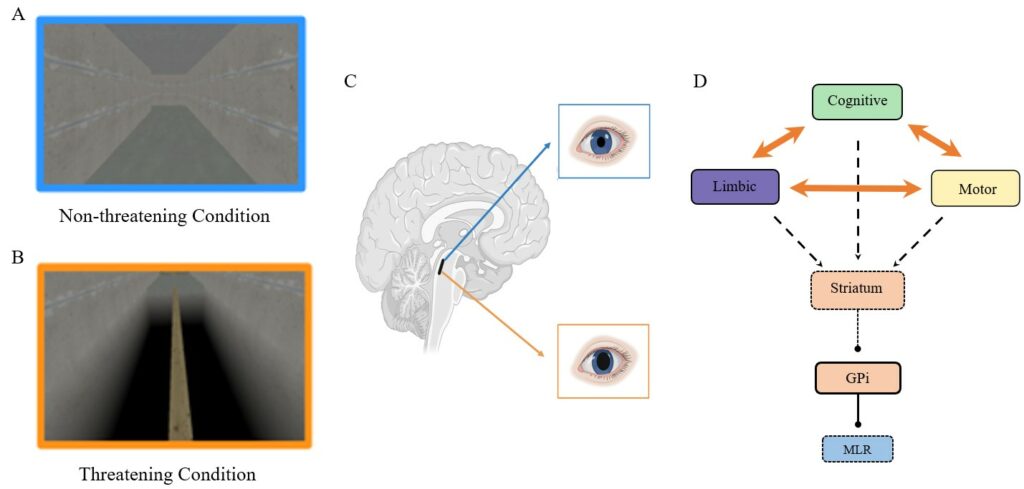By Kaylena Ehgoetz Martens
Freezing of gait is characterised by a sudden inability to initiate or continue walking which significantly impacts quality of life in people living with Parkinson’s disease. Since dopaminergic replacement therapy only partially ameliorates freezing of gait, other non-dopaminergic contributions may play a role in freezing of gait. There is evidence that sympathetic arousal increases prior to a freezing episode, particularly when freezing is triggered by stress. This highlights a potential neural mechanism to underpin the relationship between anxiety and freezing of gait. Despite a growing body of evidence that suggests anxiety may be a crucial contributor to freezing of gait, no research study has investigated changes in functional network architecture as a result of induced-anxiety which often triggers freezing of gait. Here, we aimed to investigate how anxiety-inducing contexts might ‘set the stage for freezing’, through the ascending arousal system, by examining an anxiety-inducing virtual reality gait paradigm inside functional magnetic resonance imaging (fMRI).
We used a virtual reality gait paradigm to navigate a virtual plank that has been validated to elicit anxiety, whilst simultaneously collecting task-based fMRI data from individuals with idiopathic Parkinson’s disease with confirmed freezing of gait. First, we established that the threatening condition (i.e., navigating across a narrow plank above a deep pit) provoked more freezing when compared to the non-threatening condition. We established that the threatening condition was associated with heightened network integration. By utilizing a dynamic connectivity analysis, we identified patterns of increased ‘cross-talk’ within and between motor, limbic and cognitive networks in the threatening conditions. The sympathetic nature of this phenomenon was demonstrated by an increase in pupil dilation during the anxiety-inducing condition of the virtual reality gait paradigm outside of the MRI scanner.
 Figure 1: Screenshots of the virtual-reality paradigm A) non-threatening and B) threatening walking conditions. C) Graphical representation of the noradrenergic Locus Coeruleus and its influence on pupil dilation. D) ‘Cross-talk’ model depicted graphically, with “cross-talk” visualized through heightened connectivity/network integration represented by the orange boldened lines, and its subsequent influences on the Striatum, which inhibits Globus Pallidus Internus (GPi), which inhibits the Mesencephalic Locomotor Regions (‘MLR’), leading to freezing of gait.
Figure 1: Screenshots of the virtual-reality paradigm A) non-threatening and B) threatening walking conditions. C) Graphical representation of the noradrenergic Locus Coeruleus and its influence on pupil dilation. D) ‘Cross-talk’ model depicted graphically, with “cross-talk” visualized through heightened connectivity/network integration represented by the orange boldened lines, and its subsequent influences on the Striatum, which inhibits Globus Pallidus Internus (GPi), which inhibits the Mesencephalic Locomotor Regions (‘MLR’), leading to freezing of gait.
This work reveals a potential explanation for how anxiety could lead to freezing of gait. Heightened sympathetic arousal related to anxiety could increase ‘cross-talk’ between distributed cortical networks that ultimately manifest as episodes of freezing of gait. This research advances our understanding of a symptom that affects many people living with Parkinson’s disease and opens new avenues to explore for better clinical management.
Publication: Taylor, N.L., Wainstein, G., Quek, D., Lewis, S.J.G., Shine, J.M., Ehgoetz Martens, K.A. (2022) The contribution of noradrenergic activity to anxiety-induced freezing of gait. Movement Disorders, 37(7):1432-1443. DOI: 10.1002/mds.28999
About the Author

Kaylena Ehgoetz Martens
University of Waterloo, Canada
Copyright
© 2021 by the author. Except as otherwise noted, the ISPGR blog, including its text and figures, is licensed under a Creative Commons Attribution-ShareAlike 4.0 International License. To view a copy of this license, visit https://creativecommons.org/licenses/by-sa/4.0/legalcode.
ISPGR blog (ISSN 2561-4703)
Are you interested in writing a blog post for the ISPGR website? If so, please email the ISGPR Secretariat with the following information:
- First and Last Name
- Institution/Affiliation
- Paper you will be referencing


